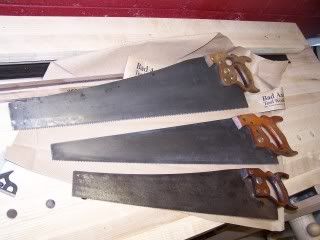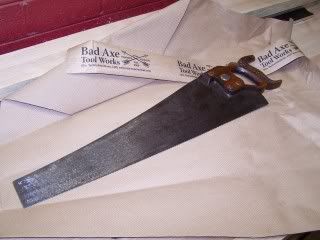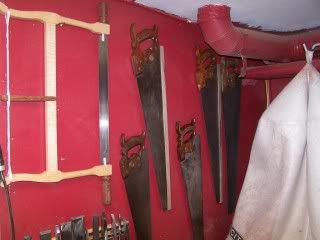Building a Nest of Saws with Help from Bad Axe Toolworks
I sent a bunch of saws to Mark Harrell at Bad Axe Tools/Technoprimitives before Christmas and began consultation with him on what my nest of saws needed. In my quest to do more and more hand work I wanted to build out a small, albeit comprehensive nest that would allow me to work cleanly and efficiently on all tasks from sizing rough stock to final dimensioning of parts. These were my thoughts on the coarse, medium, and fine makeup of this nest.
Breaking down stock to rough sizes
1 Rip saw in the 5-7 tpi range
1 Crosscut saw in the 8-9 tpi range
I would use these two saws to quickly break up longer boards in their rough state. The stock would be at minimum 4/4 but likely thicker to the 8/4 range so the tpi needed to be low to accommodate it. The cuts don’t need to be pretty so an aggressive rake would be best to allow for faster work. The set would be moderate here since I would be working in both hard and softwoods. I sent Mark a 28″ Disston D8 to be my rip saw and I have a D23 filed crosscut at 8 tpi currently in my shop ready to go. The large rip saw could also double as an effective resawing blade too.
Dimensioning rough boards to close to final size
1 Rip saw around 8 tpi
1 Crosscut saw around 10 tpi
These two saws would take my planed stock that was flat and to thickness and cut out the parts needed for whatever I am building. Thickness for 95% of my work would be 7/8 and under but speed is still somewhat of a factor especially when ripping so I wanted saws with a low tpi but still capable of producing a somewhat clean cut. My thoughts were to get this cleaner cut with a relaxed rake which would also serve to make the saw an easier starter. The set would be minimal so at the remove much less wood and allow be to work very close to the finish line while saving on plane clean up later. I sent Mark a 26″ Disston D23 to be re-toothed and filed rip and I would use my 11 tpi crosscut 20″ D8 panel saw since by this point in the process most of my parts would not be very wide and a long saw wouldn’t do much for me. This would be where I see growing the nest in the future by adding a 26″ crosscut saw, but for now the panel saw will suffice until I start building large casework and want to saw faster.
Bench Work
1 rip saw filed fine in the 10+ tpi range
1 crosscut saw also fine in the
This is really the last saw cuts that get made. In some instances it could be larger joinery like bridal joints that are deeper than the clearance of my tenon backsaw. It would be final sizing of a panel in a door or case side where I don’t need the edge to be clean since it would be housed in a joint. These will be small and clean cuts. For these operations I would use my existing crosscut panel saw but I would need a finely tuned rip saw to accompany it. I got a 19″ D8 on ebay that was file crosscut so I sent that to Mark to be filed rip.
What is so great about the service that Mark offers is the entire process is a consultation and a peek into the head of a saw expert. I told Mark what I currently have and what my goals were and he helped guide me with regard to pitch, geometry, and size. I did some initial cleaning of the saws to remove rust by following the instructions on Mark’s page and then packaged them up to be sent off to Wisconsin.
Once Mark received them he did a once over and diagnosed problems he saw like bends I didn’t catch in the saw plate and how they fit into the handle as well as the quality of the existing teeth. He sent me his findings and prognosis in an email along with his suggestions on how to set up the saws to meet my goals. Initally, Mark also suggested I contact Tom Fidgen to get his take on the content of a good nest and together, Mark and I factored in Tom’s comments to come to conclusions on the final profile of each of the 3 saws I sent him. It turns about that all of them has bends that I didn’t catch and the small panel saw was really at a point that wasn’t worth the restoration money for the outcome. Rather than leaving it at that, Mark, who is a bit of a collector, told me he had a nice little Simmonds saw that would be a great stand in and in many cases a better performer than my little Disston. I gave him the approval to move ahead with the restore on that saw and I paid the difference.
The final products are all very close to my initial ideas with some minor tweaks here and there in rake and pitch. Throughout this process Mark was highly communicative letting me know his thoughts and his project time line. The rush of orders on the Bad Axe side of the house prevented him from getting to my saws for a few weeks and he was up front with that. I told him there wasn’t a hurry to begin with anyway, All told though once Mark started working on the saws, it only took him the space of one weekend to complete the complete reshaping, re-toothing, jointing, filing, and honing of all 3 saws. The finished saws arrived on my doorstep this past Saturday and they look beautiful. Mark uses mostly recycled material for all of his packaging too.

The saws were clean and beautiful with wicked sharp teeth. My big 28″ rip saw could cut you just by handling it and the set was much less than when I sent it to him. 
As is typical whenever shop toys arrive in the mail I have a day of non stop activities outside of woodworking. I did get down to the shop briefly on Sunday and put the Simmonds panel saw to work sizing to width some shelf planks for the lower shelf on my workbench. The saw starts like a whisper and cuts really smooth leaving a clean cut that took only a pass or two with my jointer plane to be ready for tongue and groove joinery.

The saw plate is polished nicely with a clearly visible etch

The handle has a nice chip carving pattern on it and is comfortable in use.

I haven’t been able to try out the other saws but the real test will be when I start my next project and can work the work all the way from the mill to the finish, putting to work all the varying pitches and geometries to good effect.

The nest will cover just about anything I need especially when I add in the 8 tpi rip file bow saw in the foreground for awkward ripping tasks like when I needed to cut my vise chop to shape. Of course I am not including my joinery saws in this post, but know that they are very much a part of the work and I will get into a discussion of those in a future post.
Working with Mark was a pleasure and I felt that I was truly in the hands of an expert throughout. He has just updated his website as well as put a flag in the ground on Facebook where he has some lively saw discussions already underway. In fact there is a great discussion on just what makes up an ideal nest of saws. Head over there and check it out.

